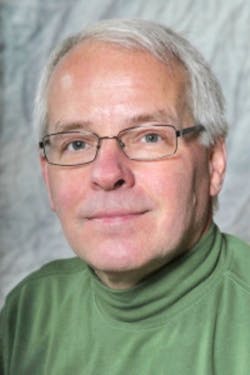Waymo virtual self-driving cars log 8 million miles per day
“In a corner of Alphabet’s campus, there is a team working on a piece of software that may be the key to self-driving cars,” writes Alexis C. Madrigal at The Atlantic. “No journalist has ever seen it in action until now. They call it Carcraft, after the popular game World of Warcraft.”
Madrigal’s first look is a simple line drawing of a roundabout. “We see a self-driving Chrysler Pacifica at medium resolution and a simple wireframe box indicating the presence of another vehicle,” he explains. The simulation represents a real two-lane roundabout in Texas, where a real Waymo self-driving vehicle was flummoxed on encountering another vehicle.
To study the situation, Waymo build a lookalike physical roundabout at a test facility; the simulation represents the third step in the learning process in which, Madrigal explains, “…a single real-world driving maneuver…can be amplified into thousands of simulated scenarios that probe the edges of the car’s capabilities.”
Madrigal quotes James Stout, Carcraft’s creator, as saying, “The vast majority of work done—new feature work—is motivated by stuff seen in simulation.”
At any given time, Madrigal writes, 25,000 virtual self-driving cars are traversing simulated versions of Austin, Mountain View, and Phoenix as well as test tracks. He says, “Collectively, they now drive 8 million miles per day in the virtual world. In 2016, they logged 2.5 billion virtual miles versus a little over 3 million miles by Google’s IRL self-driving cars that run on public roads.” Further, the simulated miles can be more “interesting”—or “spicy” in Waymo’s term of art—than boring real miles. Madrigal explains that the simulations are tightly interwoven with the millions of miles Waymo vehicles have traveled on public roads and at a secret base called Castle in the Central Valley.
In his article in The Atlantic, Madrigal describes the Castle facility (“…there are whiffs of Manhattan Project, of scientific outpost, of tech startup…”) and the people who populate it (including “foxes” who drive conventional cars, act as pedestrians, ride bikes, and hold stop signs—actors whose audience is the car). He also tours Waymo headquarters in Mountain View. The entire article is worth reading.
See also “Controlled environments help evaluate connected vehicles.”
About the Author

Rick Nelson
Contributing Editor
Rick is currently Contributing Technical Editor. He was Executive Editor for EE in 2011-2018. Previously he served on several publications, including EDN and Vision Systems Design, and has received awards for signed editorials from the American Society of Business Publication Editors. He began as a design engineer at General Electric and Litton Industries and earned a BSEE degree from Penn State.
